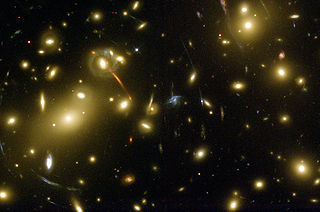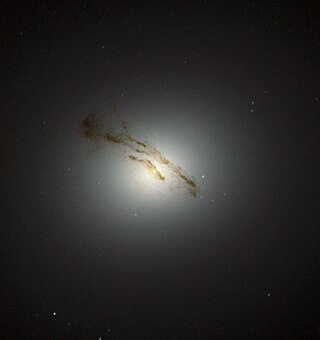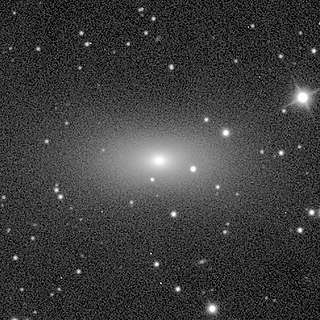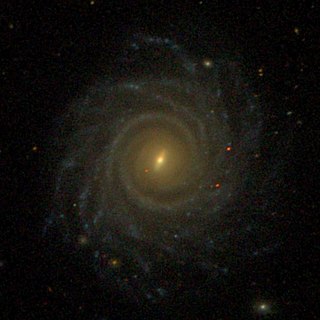Related Research Articles

The Virgo Cluster is a large cluster of galaxies whose center is 53.8 ± 0.3 Mly away in the constellation Virgo. Comprising approximately 1,300 member galaxies, the cluster forms the heart of the larger Virgo Supercluster, of which the Local Group is a member. The Local Group actually experiences the mass of the Virgo Supercluster as the Virgocentric flow. It is estimated that the Virgo Cluster's mass is 1.2×1015M☉ out to 8 degrees of the cluster's center or a radius of about 2.2 Mpc.

Abell 2218 is a large cluster of galaxies over 2 billion light-years away in the constellation Draco.

Messier 32 is a dwarf "early-type" galaxy about 2,650,000 light-years (810,000 pc) from the Solar System, appearing in the constellation Andromeda. M32 is a satellite galaxy of the Andromeda Galaxy (M31) and was discovered by Guillaume Le Gentil in 1749.

Messier 84 or M84, also known as NGC 4374, is a giant elliptical or lenticular galaxy in the constellation Virgo. Charles Messier discovered the object in 1781 in a systematic search for "nebulous objects" in the night sky. It is the 84th object in the Messier Catalogue and in the heavily populated core of the Virgo Cluster of galaxies, part of the local supercluster.

The Carina Dwarf Spheroidal Galaxy is a dwarf galaxy in the Carina constellation. It was discovered in 1977 with the UK Schmidt Telescope by Cannon et al. The Carina Dwarf Spheroidal galaxy is a satellite galaxy of the Milky Way and is receding from it at 230 km/s. The diameter of the galaxy is about 1600 light-years, which is 75 times smaller than the Milky Way. Most of the stars in the galaxy formed 7 billion years ago, although it also experienced bursts of star formation about 13 and 3 billion years ago. It is also being tidally disrupted by the Milky Way galaxy.
45 Boötis is a single star located 63 light years away from the Sun in the northern constellation of Boötes. It has the Bayer designation c Boötis; 45 Boötis is the Flamsteed designation. This body is visible to the naked eye as a faint, yellow-white hued star with an apparent visual magnitude of 4.93. It has a relatively high proper motion, traversing the celestial sphere at the rate of 0.247″ per year. The star is moving closer to the Earth with a heliocentric radial velocity of −11 km/s, and is a stream member of the Ursa Major Moving Group.
Andromeda V is a dwarf spheroidal galaxy about 2.52 Mly away in the constellation Andromeda.

NGC 7052 is an elliptical galaxy in the constellation Vulpecula. The galaxy harbours a supermassive black hole with mass c. 220-630 million solar masses in its nucleus.
The Freeman law is a statement in astronomy which says that disk galaxies have the same surface brightness, Σ at the center. It was described in 1970 by Ken Freeman.

V636 Scorpii is a multiple star system in the constellation Scorpius, 3,000 light years away. The primary is a Classical Cepheid variable and its visual magnitude varies from 6.4 to 6.9.
Stacy McGaugh is an American astronomer and professor in the Department of Astronomy at Case Western Reserve University in Cleveland, Ohio. His fields of specialty include low surface brightness galaxies, galaxy formation and evolution, tests of dark matter and alternative hypotheses, and measurements of cosmological parameters.

NGC 6166 is an elliptical galaxy in the Abell 2199 cluster. It lies 490 million light years away in the constellation Hercules. The primary galaxy in the cluster, it is one of the most luminous galaxies known in terms of X-ray emissions.

NGC 1052 is an elliptical galaxy in the constellation Cetus. It was discovered on January 10, 1785 by the astronomer William Herschel. It is a member of the eponymous NGC 1052 Group.
56 Cygni is a single star in the northern constellation of Cygnus, located 135 light years from Earth. It is visible to the naked eye as a white-hued star with an apparent visual magnitude of 5.06. The star is moving closer to the Earth with a heliocentric radial velocity of −21.5. It has a relatively high proper motion, traversing the celestial sphere at an angular rate of 0.181″/yr. According to Eggen (1998), this is a member of the Hyades Supercluster.

NGC 3862 is an elliptical galaxy located 300 million light-years away in the constellation Leo. Discovered by astronomer William Herschel on April 27, 1785, NGC 3862 is an outlying member of the Leo Cluster.

NGC 3883 is a large low surface brightness spiral galaxy located about 330 million light-years away in the constellation Leo. NGC 3883 has a prominent bulge but does not host an AGN. The galaxy also has flocculent spiral arms in its disk. It was discovered by astronomer William Herschel on April 13, 1785 and is a member of the Leo Cluster.

NGC 3367 is a barred spiral galaxy located in the constellation Leo. It is located at a distance of about 120 million light years from Earth, which, given its apparent dimensions, means that NGC 3367 is about 85,000 light years across. It was discovered by William Herschel on March 19, 1784.

NGC 5846 is an elliptical galaxy located in the constellation Virgo. It is located at a distance of circa 90 million light years from Earth, which, given its apparent dimensions, means that NGC 5846 is about 110,000 light years across. It was discovered by William Herschel on February 24, 1786. It lies near 110 Virginis and is part of the Herschel 400 Catalogue. It is a member of the NGC 5846 Group of galaxies, itself one of the Virgo III Groups strung out to the east of the Virgo Supercluster of galaxies.

NGC 765 is an intermediate spiral galaxy located in the constellation Aries. It is located at a distance of circa 220 million light years from Earth, which, given its apparent dimensions, means that NGC 765 is about 195,000 light years across. It was discovered by Albert Marth on October 8, 1864. The galaxy has an extensive hydrogen (HI) disk with low surface brightness, whose diameter is estimated to be 240 kpc.

NGC 972 is a dusty spiral galaxy in the northern constellation of Aries, located at an approximate distance of 49.8 Mly from the Milky Way. It was discovered in 1784 by William Herschel. The galactic features suggest it may have undergone a merger with a gas-rich companion, giving it asymmetrical arms, plus starburst activity in the nucleus and an off-planar nuclear ring. The inner 3.6 kpc of the galaxy is undergoing star formation at the rate of 2.1–2.7 M☉·yr−1, but it lacks a nuclear bulge.
References
- ↑ Astronomische Nachrichten, "On the Emptiness of Voids", K.-H. Schmidt; Petra Böhm; Hans Elsässer; vol. 318, no. 2, p. 81, Bibcode : 1997AN....318...81S
- ↑ "An Introduction to Galaxies and Cosmology", David J. Adams and others
- 1 2 Pieter G. van Dokkum (27 June 2005). "The Recent and Continuing Assembly of Field Ellipticals by Red Mergers". The Astronomical Journal (published December 2005). 130 (6): 2647–2665. arXiv: astro-ph/0506661 . Bibcode:2005AJ....130.2647V. doi:10.1086/497593. S2CID 250814170.
- 1 2 3 4 5 6 7 8 9 10 11 12 Jürgen Materne (April 1979). "The structure of nearby groups of galaxies – Quantitative membership probabilities". Astronomy & Astrophysics . 74 (2): 235–243. Bibcode:1979A&A....74..235M.
- ↑ "Lonely galaxy lost in space". Space Daily. 11 June 2015.
- ↑ "NGC 6503". NASA/IPAC Extragalactic Database.
- ↑ "NGC 6503". SIMBAD . Centre de données astronomiques de Strasbourg . Retrieved 26 February 2018.
- ↑ Piero Madau; Lucia Pozzetti; Mark Dickinson (1998). "The Star Formation History of Field Galaxies". The Astrophysical Journal (published May 1998). 498 (1): 106–116. arXiv: astro-ph/9708220 . Bibcode:1998ApJ...498..106M. doi:10.1086/305523. S2CID 499769.